Evolvement Investigation of Secondary Electron Emission for Ultrathin MgO Coatings Prepared by Atomic Layer Deposition
Abstract
:1. Introduction
2. Preparation and SEY Characterization Methods of MgO Coatings
2.1. Preparation of MgO Coatings by ALD
2.2. SEY Measurement of MgO Coatings
2.3. Energy Spectrum and Surface Analysis Methods
3. Results and Discussions
3.1. Surface Analysis of MgO/Si Double-Layer Structures
3.2. SEE Characteristics of MgO/Si Double-Layer Structures
3.3. Secondary Electron Energy Spectra Characterization
3.4. Theoretical Analyzation of SEE Processes in a Double-Layer Structure
3.5. Theoretical Explanation on the SEE Properties of MgO/Si Double-Layer Structures
4. Conclusions
Author Contributions
Funding
Institutional Review Board Statement
Informed Consent Statement
Data Availability Statement
Conflicts of Interest
References
- Seiler, H. Secondary-Electron Emission in the Scanning Electron-Microscope. J. Appl. Phys. 1983, 54, R1–R18. [Google Scholar] [CrossRef]
- Sauli, F. The gas electron multiplier (GEM): Operating principles and applications. Nucl. Instrum. Meth. A 2016, 805, 2–24. [Google Scholar] [CrossRef]
- Xia, L.S.; Yang, A.M.; Chen, Y.; Zhang, H.; Liu, X.G.; Li, J.; Jiang, X.G.; Zhang, K.Z.; Shi, J.S.; Deng, J.J. Multi-pulsed intense electron beam emission from velvet, carbon fibers, carbon nano-tubes and dispenser cathodes. Chin. Phys. C 2010, 34, 1733–1737. [Google Scholar] [CrossRef]
- Johnson, C.B.; Catchpole, C.E.; Matle, C.C. Microchannel Plate Inverter Image Intensifiers. IEEE Trans. Electron. Dev. 1971, 18, 1113–1116. [Google Scholar] [CrossRef]
- Leskovar, B. Microchannel Plates. Phys. Today 1977, 30, 42–49. [Google Scholar] [CrossRef] [Green Version]
- Wiza, J.L. Microchannel Plate Detectors. Nucl. Instrum. Meth. 1979, 162, 587–601. [Google Scholar] [CrossRef]
- Vaughan, J.R.M. Multipactor. IEEE Trans. Electron. Dev. 1988, 35, 1172–1180. [Google Scholar] [CrossRef]
- Fil, N.; Belhaj, M.; Hillairet, J.; Puech, J. Multipactor threshold sensitivity to total electron emission yield in small gap waveguide structure and TEEY models accuracy. Phys. Plasmas 2016, 23, 123118. [Google Scholar] [CrossRef]
- Guo, Z.Y.; Liu, Y.D.; Qin, Q.; Wang, J.Q.; Xing, J. Studies on Electron Cloud Instability in the BEPC. High. Energy Phys. Nucl. Phys. 2006, 30, 102–104. [Google Scholar] [CrossRef]
- Cimino, R.; Demma, T. Electron cloud in accelerators. Int. J. Mod. Phys. A 2014, 29, 1430023. [Google Scholar] [CrossRef]
- Ye, M.; He, Y.N.; Wang, R.; Hu, T.C.; Zhang, N.; Yang, J.; Cui, W.Z.; Zhang, Z.B. Suppression of secondary electron emission by micro-trapping structure surface. Acta Phys. Sin. 2014, 63, 147901. [Google Scholar] [CrossRef]
- Wang, D.; Ye, M.; Feng, P.; He, Y.N.; Cui, W.Z. An effective reduction on secondary electron emission yield of gold coated surfaces by laser etching. Acta Phys. Sin. 2019, 68, 067901. [Google Scholar] [CrossRef]
- Guo, J.J.; Wang, D.; Xu, Y.T.; Zhu, X.P.; Wen, K.L.; Miao, G.H.; Cao, W.W.; Si, J.H.; Lu, M.; Guo, H.T. Secondary electron emission characteristics of Al2O3 coatings prepared by atomic layer deposition. AIP Adv. 2019, 9, 095303. [Google Scholar] [CrossRef]
- Zhu, X.P.; Guo, J.J.; Cao, W.W.; Liu, L.T.; Si, J.H. Theoretical and experimental investigation of secondary electron emission characteristics of ALD-ZnO conductive films. J. Appl. Phys. 2020, 128, 065102. [Google Scholar] [CrossRef]
- Wang, D.; He, Y.N.; Cui, W.Z. Secondary electron emission characteristics of TiN coatings produced by RF magnetron sputtering. J. Appl. Phys. 2018, 124, 053301. [Google Scholar] [CrossRef]
- Cartiglia, N.; Arcidiacono, R.; Baselga, M.; Bellan, R.; Boscardin, M.; Cenna, F.; Dalla Betta, G.F.; Fernndez-Martnez, P.; Ferrero, M.; Flores, D.; et al. Design optimization of ultra-fast silicon detectors. Nucl. Instrum. Meth. A 2015, 796, 141–148. [Google Scholar] [CrossRef]
- Fernandez-Martinez, P.; Pellegrini, G.; Balbuena, J.P.; Quirion, D.; Hidalgo, S.; Flores, D.; Lozano, M.; Casse, G. Simulation of new p-type strip detectors with trench to enhance the charge multiplication effect in the n-type electrode. Nucl. Instrum. Meth. A 2011, 658, 98–102. [Google Scholar] [CrossRef]
- Mankel, R. Pattern recognition and event reconstruction in particle physics experiments. Rep. Prog. Phys. 2004, 67, 553. [Google Scholar] [CrossRef]
- van der Graaf, H.; Akhtar, H.; Budko, N.; Chan, H.W.; Hagen, C.W.; Hansson, C.C.; Nützel, G.; Pinto, S.D.; Prodanović, V.; Raftari, B.; et al. The Tynode: A new vacuum electron multiplier. Nucl. Instrum. Meth. A 2017, 847, 148–161. [Google Scholar] [CrossRef] [Green Version]
- Tao, S.X.; Chan, H.W.; van der Graaf, H. Secondary Electron Emission Materials for Transmission Dynodes in Novel Photomultipliers: A Review. Materials 2016, 9, 1017. [Google Scholar] [CrossRef]
- Bolton, J.H.; Williams, S.E. Use of a Photomultiplier to Measure Intensities in the Vacuum Ultra-Violet Region. Nature 1952, 169, 325–326. [Google Scholar] [CrossRef]
- Henrich, V.E.; Fan, J.C.C. High-efficiency secondary-electron emission from sputtered MgO-Au cermets. Appl. Phys. Lett. 1973, 23, 7–8. [Google Scholar] [CrossRef]
- Choi, E.H.; Lim, J.Y.; Kim, Y.G.; Ko, J.J.; Kim, D.I.; Lee, C.W.; Cho, G.S. Secondary electron emission coefficient of a MgO single crystal. J. Appl. Phys. 1999, 86, 6525–6527. [Google Scholar] [CrossRef]
- Prodanovic, V.; Chan, H.W.; Mane, A.U.; Elam, J.W.; Minjauw, M.M.; Detavernier, C.; Harry, V.D.G.; Sarro, P.M. Effect of thermal annealing and chemical treatments on secondary electron emission properties of atomic layer deposited MgO. J. Vac. Sci. Technol. A 2018, 36, 06A102. [Google Scholar] [CrossRef] [Green Version]
- Lee, J.; Jeong, T.; Yu, S.G.; Jin, S.; Heo, J.; Yi, W.; Jeon, D.; Kim, J.M. Thickness effect on secondary electron emission of MgO layers. Appl. Surf. Sci. 2001, 174, 62–69. [Google Scholar] [CrossRef]
- Li, J.; Hu, W.; Hao, L.; Gao, B.; Li, Y. Secondary electron emission enhancement of MgO/Au composite film by adopting a gold buffer layer. Mater. Res. Bull. 2019, 118, 110493. [Google Scholar] [CrossRef]
- Manalio, A.A.; Burin, K.; Rothberg, G.M. More efficient channel electron multiplier by coating of the cone with a high secondary electron yield material. Rev. Sci. Instrum. 1981, 52, 1490–1492. [Google Scholar] [CrossRef]
- Vink, T.J.; Balkenende, A.R.; Verbeek, R.G.F.A.; van Hal, H.A.M.; de Zwart, S.T. Materials with a high secondary-electron yield for use in plasma displays. Appl. Phys. Lett. 2002, 80, 2216–2218. [Google Scholar] [CrossRef]
- Ohtsu, Y.; Fujita, H. Production of high-density capacitively coupled radio-frequency discharge plasma by high-secondary-electron-emission oxide. Appl. Phys. Lett. 2004, 85, 4875–4877. [Google Scholar] [CrossRef]
- Wang, D.; He, Y.N.; Guo, J.J.; Cai, Y.H.; Mao, Z.S.; Ye, M. Investigation on secondary electron emission characteristics of double-layer structures. J. Appl. Phys. 2021, 129, 093304. [Google Scholar] [CrossRef]
- Young, J.R. Penetration of electrons and ions in aluminum. J. Appl. Phys. 1956, 27, 1–4. [Google Scholar] [CrossRef]
- Lane, R.O.; Zaffarano, D.J. Transmission of 0–40 keV electrons by thin films with application to beta-ray spectroscopy. Phys. Rev. 1954, 94, 960–964. [Google Scholar] [CrossRef]
- Dionne, G.F. Effects of secondary electron scattering on secondary emission yield curves. J. Appl. Phys. 1973, 44, 5361–5364. [Google Scholar] [CrossRef]
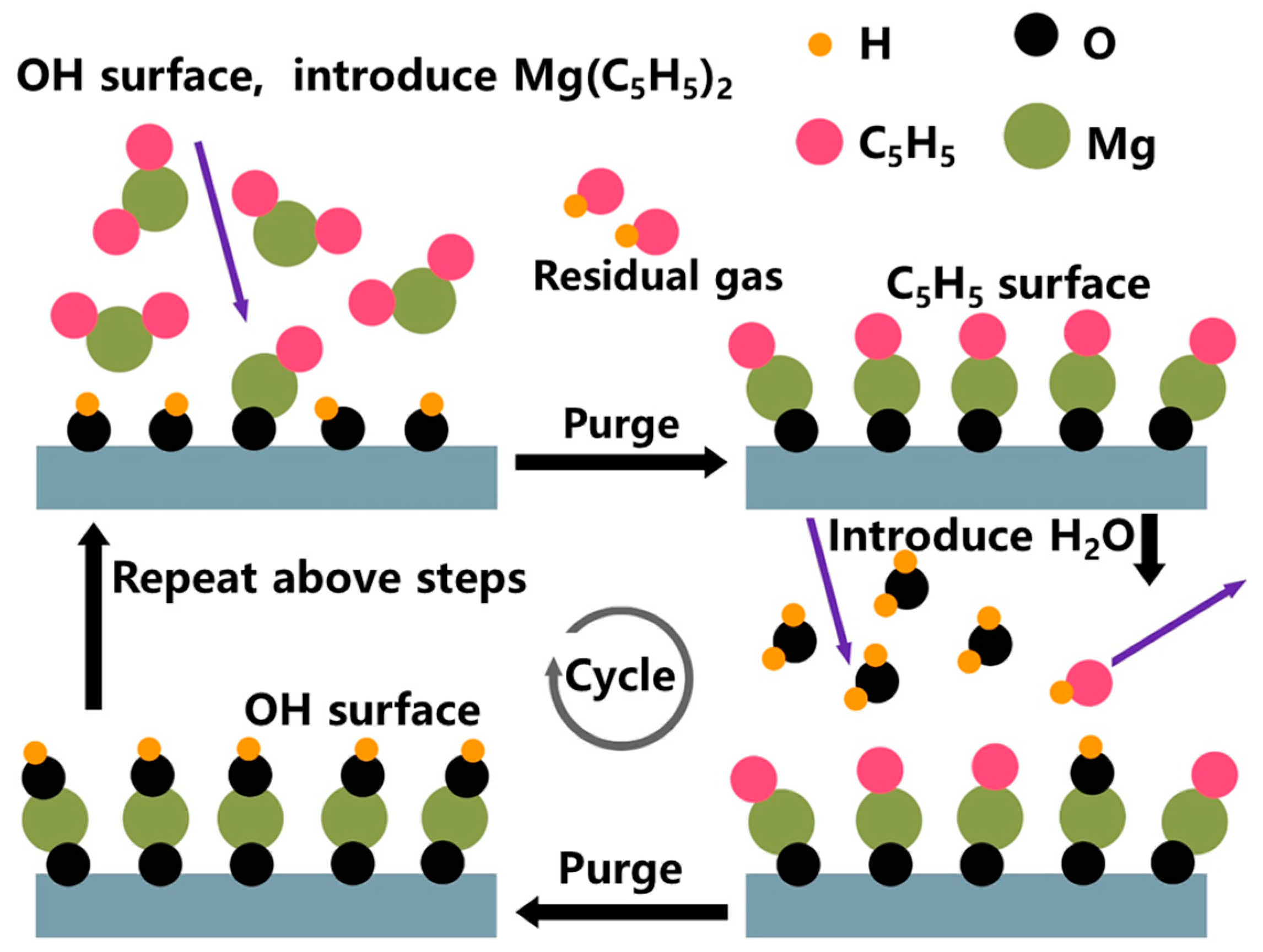
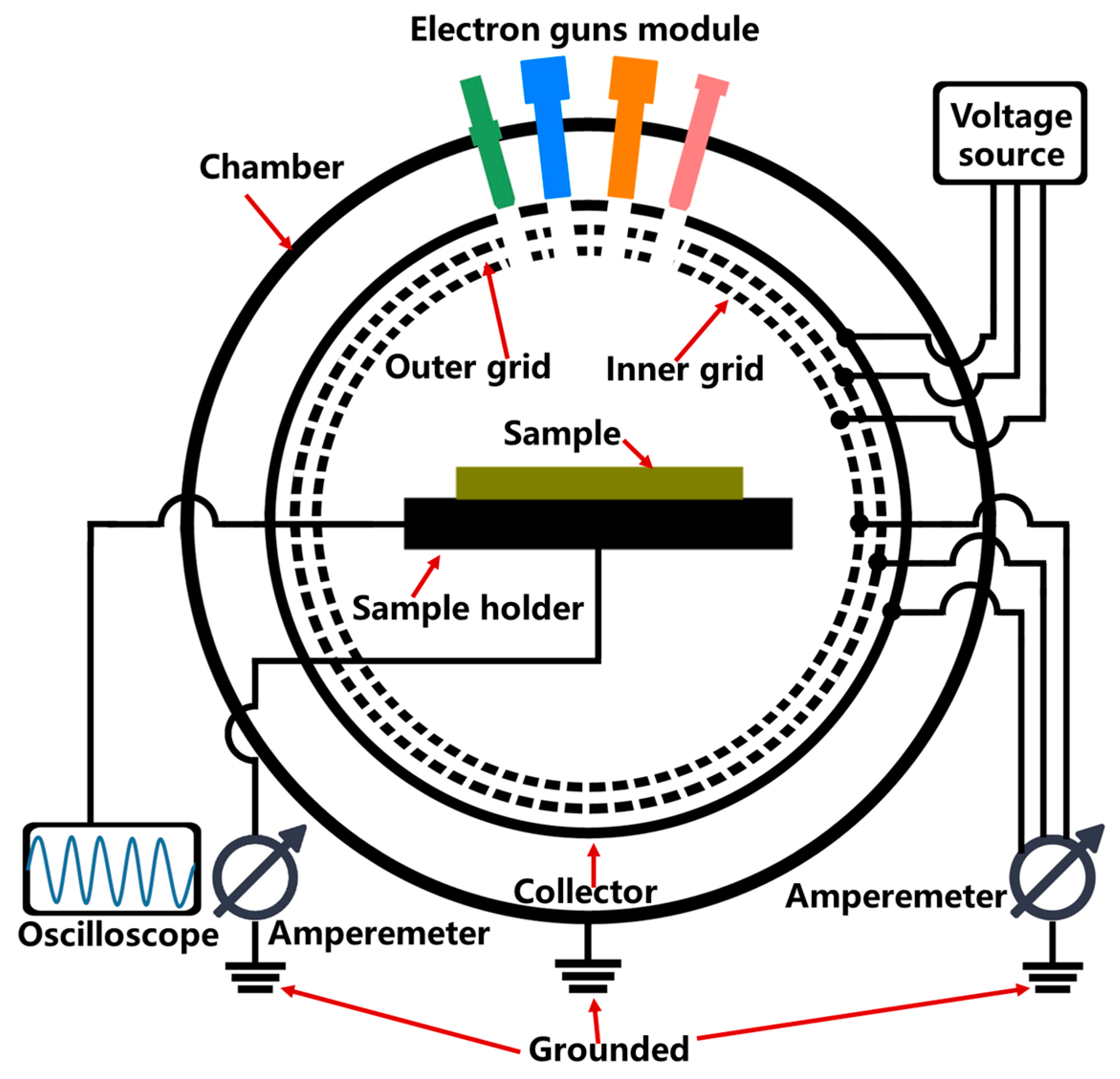
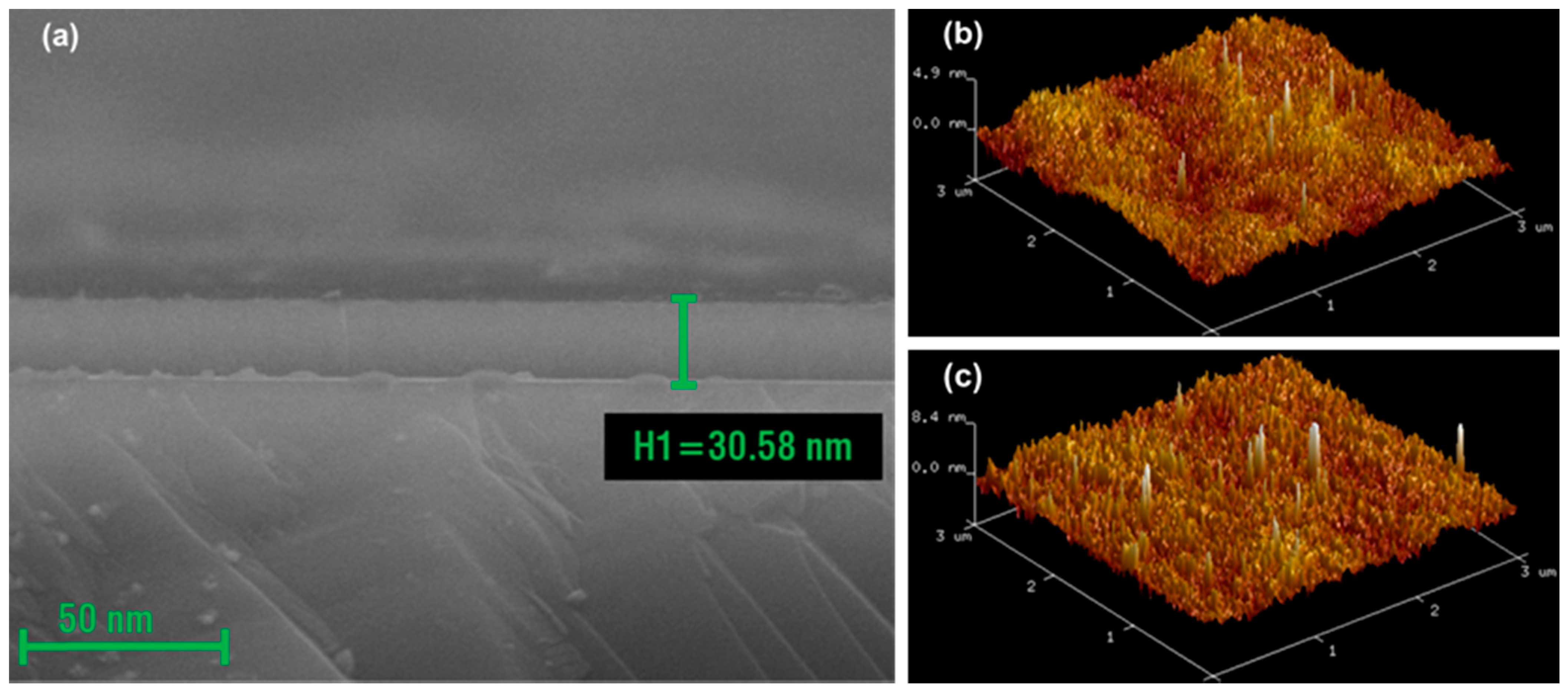
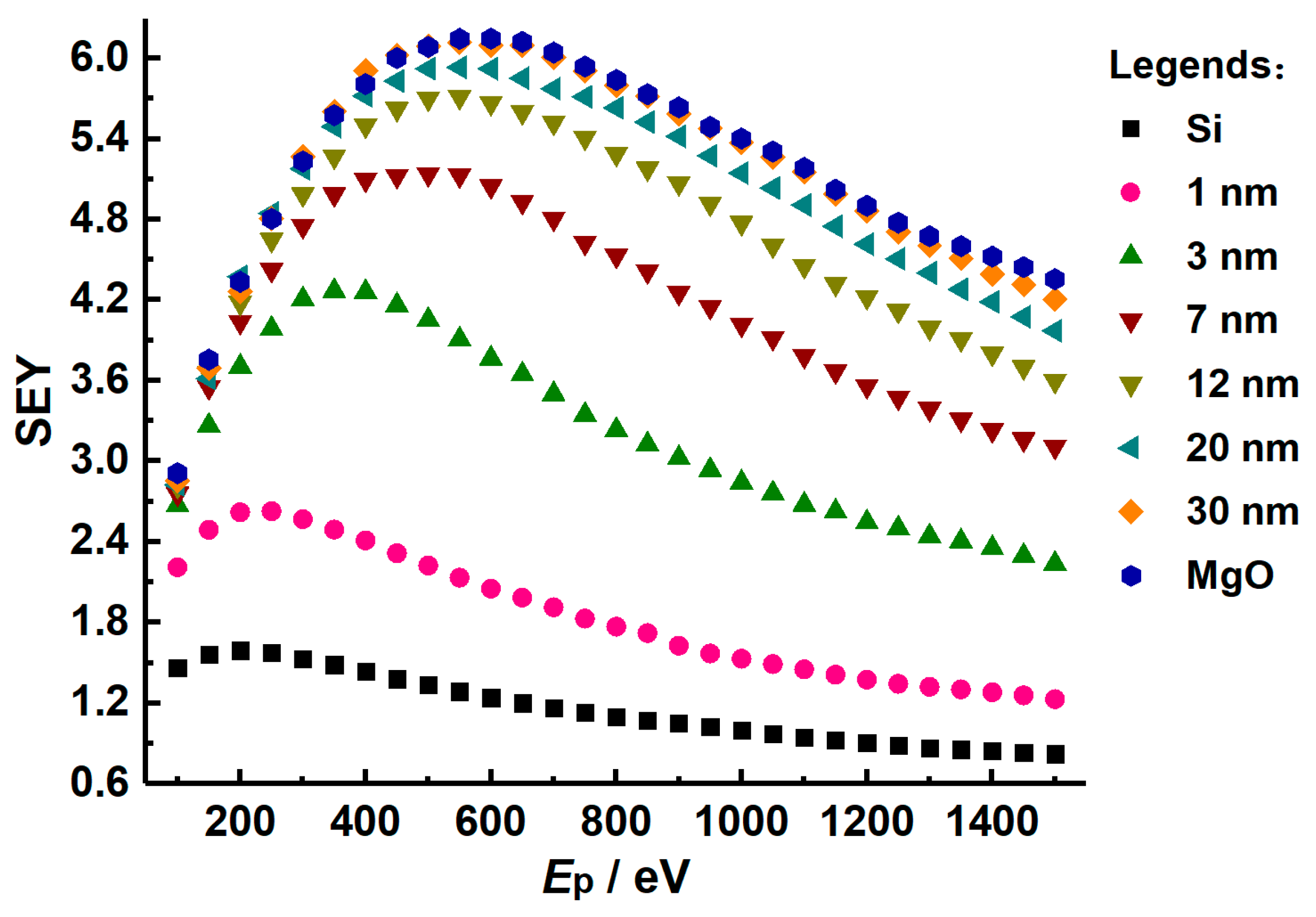
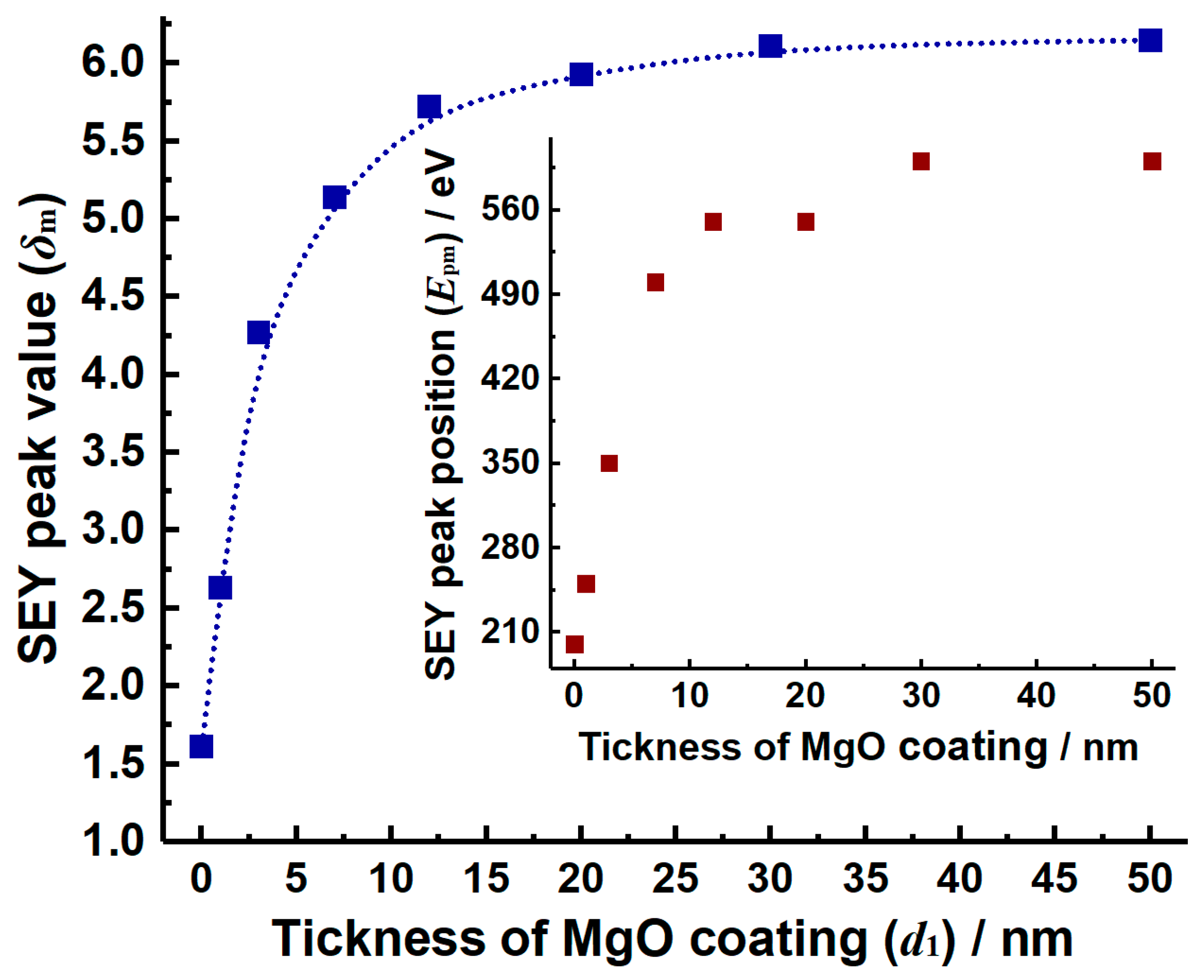
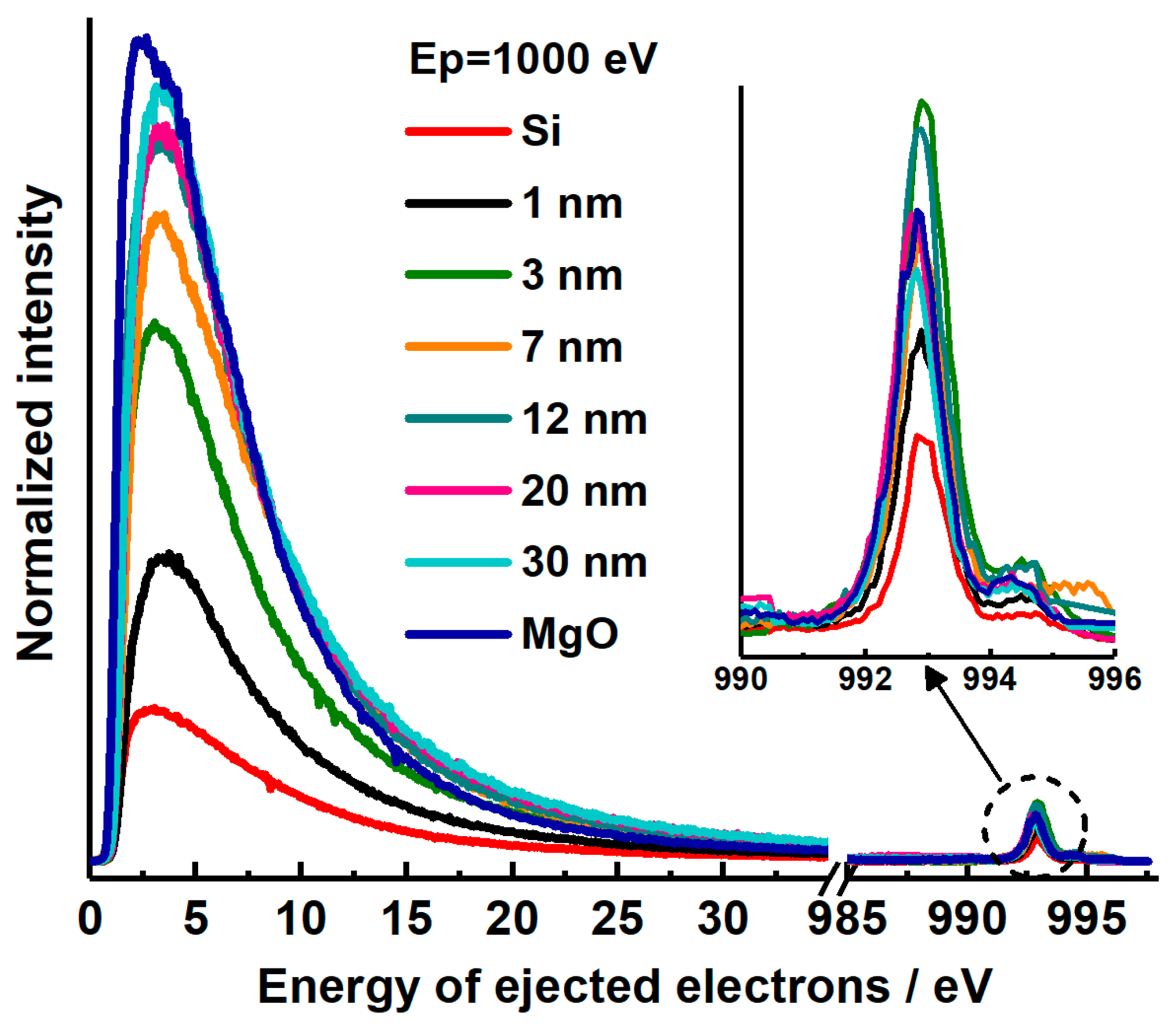
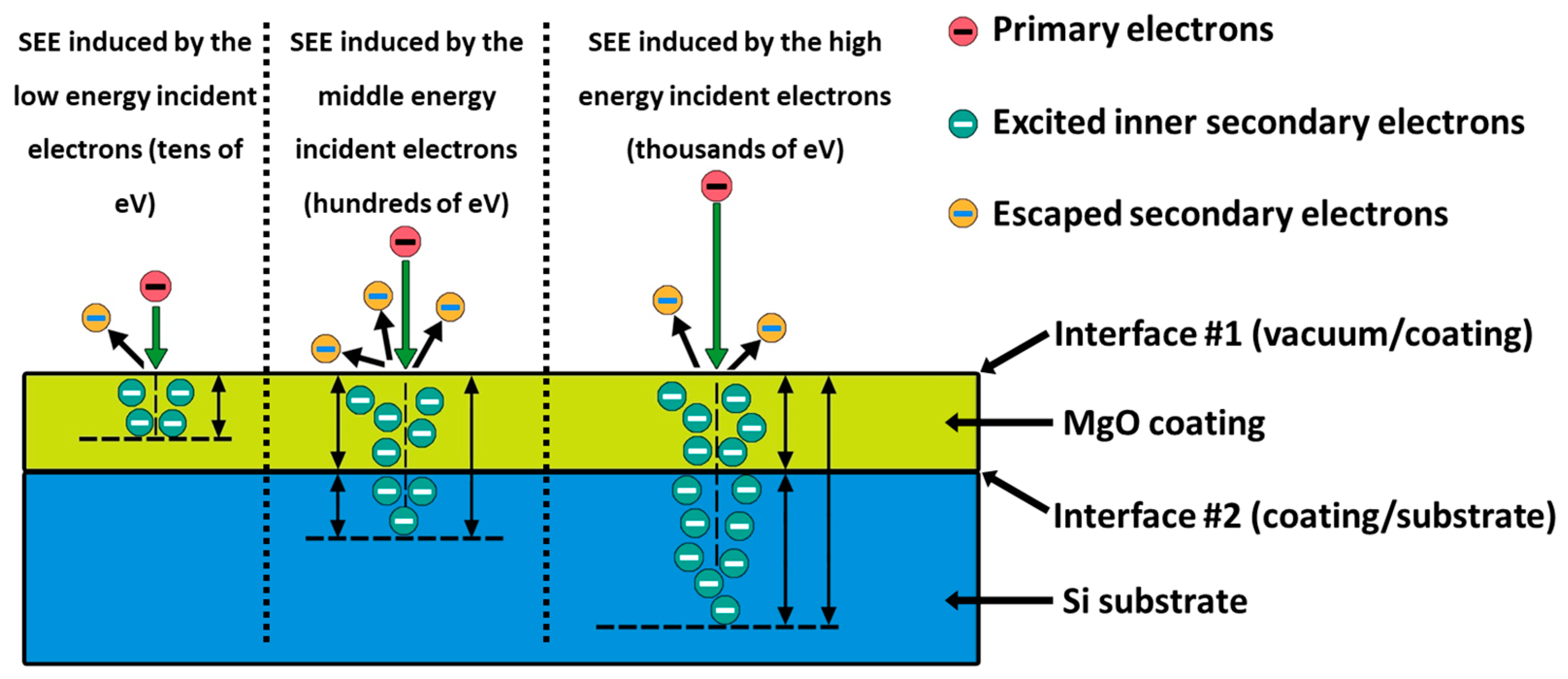

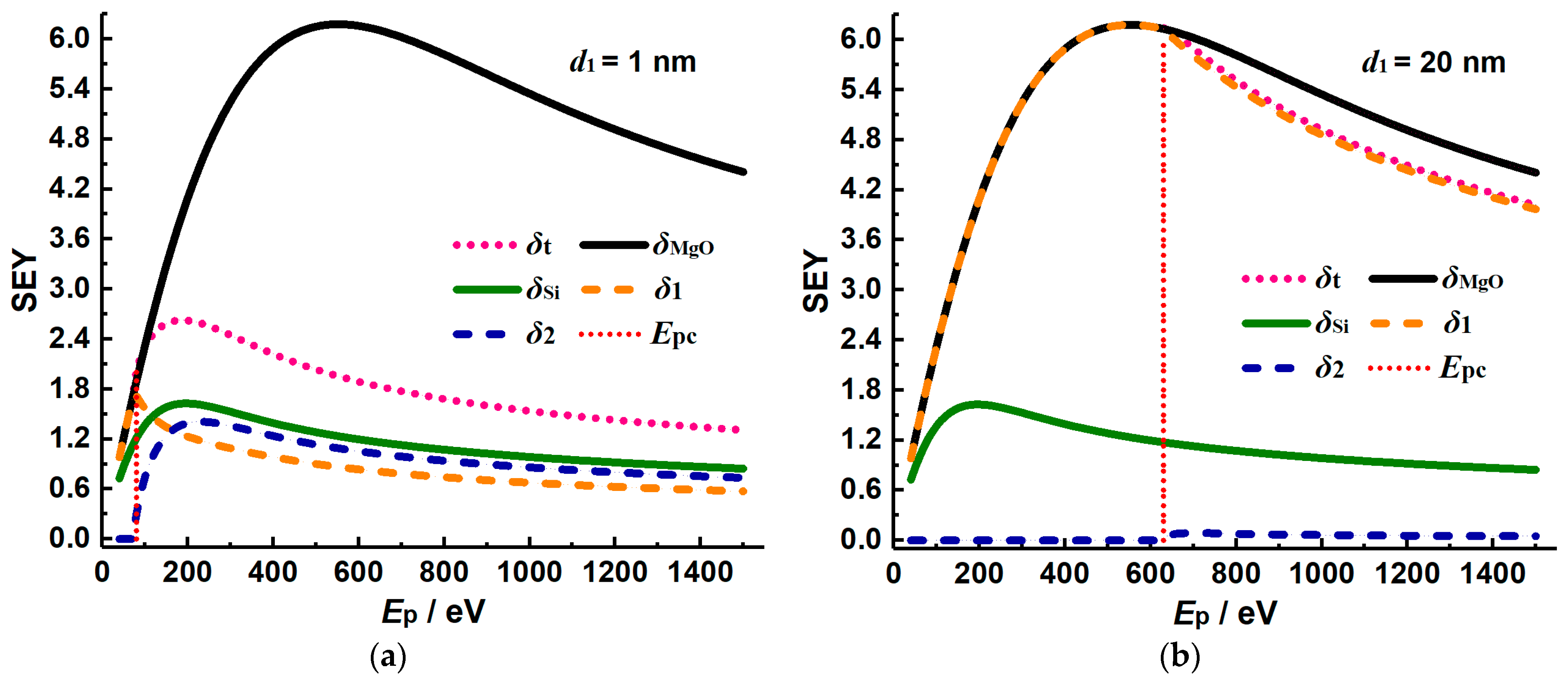
| Parameter | MgO | Si | 1 nm | 3 nm | 7 nm | 12 nm | 20 nm | 30 nm |
|---|---|---|---|---|---|---|---|---|
| δm | 6.15 | 1.61 | 2.63 | 4.27 | 5.14 | 5.72 | 5.93 | 6.11 |
| Epm/eV | 600 | 200 | 250 | 350 | 500 | 550 | 550 | 600 |
| Material | A | B | λ/nm | Ea/eV |
|---|---|---|---|---|
| Si | 2400 | 0.023 | 0.2 | 1.12 |
| MgO | 3500 | 0.225 | 1.3 | 9.00 |
Publisher’s Note: MDPI stays neutral with regard to jurisdictional claims in published maps and institutional affiliations. |
© 2021 by the authors. Licensee MDPI, Basel, Switzerland. This article is an open access article distributed under the terms and conditions of the Creative Commons Attribution (CC BY) license (https://creativecommons.org/licenses/by/4.0/).
Share and Cite
Zhu, X.; Guo, J.; Li, X.; Zhou, R.; Wang, D.; Zhao, W. Evolvement Investigation of Secondary Electron Emission for Ultrathin MgO Coatings Prepared by Atomic Layer Deposition. Appl. Sci. 2021, 11, 4801. https://doi.org/10.3390/app11114801
Zhu X, Guo J, Li X, Zhou R, Wang D, Zhao W. Evolvement Investigation of Secondary Electron Emission for Ultrathin MgO Coatings Prepared by Atomic Layer Deposition. Applied Sciences. 2021; 11(11):4801. https://doi.org/10.3390/app11114801
Chicago/Turabian StyleZhu, Xiangping, Junjiang Guo, Xiangxin Li, Rundong Zhou, Dan Wang, and Wei Zhao. 2021. "Evolvement Investigation of Secondary Electron Emission for Ultrathin MgO Coatings Prepared by Atomic Layer Deposition" Applied Sciences 11, no. 11: 4801. https://doi.org/10.3390/app11114801
APA StyleZhu, X., Guo, J., Li, X., Zhou, R., Wang, D., & Zhao, W. (2021). Evolvement Investigation of Secondary Electron Emission for Ultrathin MgO Coatings Prepared by Atomic Layer Deposition. Applied Sciences, 11(11), 4801. https://doi.org/10.3390/app11114801







